What will the future look like when everything can be banked?
- 核心观点:区块链技术将解绑传统银行业务。
- 关键要素:
- 《GENIUS法案》允许非银行机构持有稳定币存款。
- 稳定币结算成本远低于传统支付网络。
- 链上合规可实现实时透明监管。
- 市场影响:催生新一代低成本数字银行。
- 时效性标注:中期影响。
Original article by: Soel John and Sumanth Neppalli, Decentralised.co
Original translation: AididiaoJP, Foresight News
Cryptocurrency is now true fintech.
This article explores how legislative changes could untether traditional banks. If blockchains are the monetary rails and everything is a marketplace, users will ultimately leave their unused deposits in their preferred apps. This, in turn, will allow balances to accumulate in apps with immense distribution power.
In the future, everything can be a bank, but how can it be achieved?
The GENIUS Act allows applications to hold US dollars on their users' behalf (in the form of stablecoins). This creates incentives for platforms to deposit funds and spend them directly through applications. But banks are more than just vaults storing US dollars; they are complex databases layered with logic and compliance. In today's session, we explore how the technology stack supporting this shift is evolving.
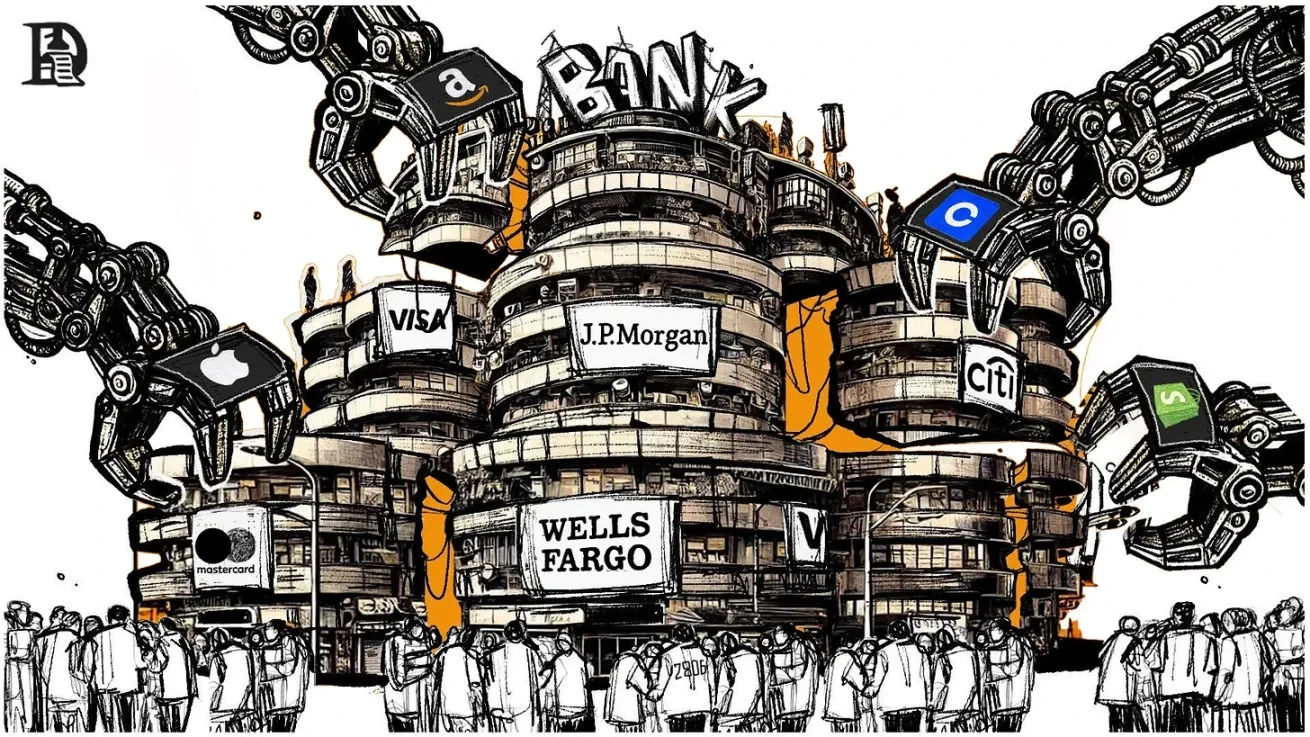
Most of the fintech platforms we use are essentially wrappers around the same underlying banks. So instead of chasing the next shiny payment product, we started building relationships directly with the banks themselves.
You can't build a startup on top of another startup. You need a direct relationship with the entity that actually does the work so that if something goes wrong, you're not stuck playing word games with multiple middlemen. As a founder, choosing a stable, if slightly legacy, vendor can save you hundreds of hours and an equal number of emails back and forth.
In the banking industry, most profits are generated where the money is. Traditional banks hold billions in user deposits and likely have in-house compliance teams. Compared to a startup whose founders are worried about their licenses, a bank can be a safer option.
But at the same time, sitting in the middle of high-frequency asset turnover can also generate huge profits. Robinhood doesn't "hold" stock certificates, and most cryptocurrency trading terminals don't custody users' assets. Yet, they generate billions of dollars in fees each year.
This is a tug-of-war between two contrasting forces in the financial world, a tug-of-war between the desire for custody and the desire to be the layer where transactions occur. Your traditional bank might feel conflicted about letting you trade meme coins for assets they hold in custody, since they make money on deposits. But at the same time, exchanges make money by convincing you that wealth is created by betting on the next meme token.
Underlying this friction is the evolving concept of a portfolio. By contrast, a savvy 27-year-old today might consider her Ethereum holdings, the rights to Sabrina Carpenter's music, and streaming dividends from "My Oxford Year" to be a safe addition to her portfolio, alongside gold and stock certificates. While neither the rights nor the streaming dividends currently exist, evolving smart contracts and regulations are likely to make them possible over the next decade.
If the very definition of an investment portfolio changes, then where we store our wealth will also change. Few areas demonstrate this shift more clearly than today's banks. Banks capture 97% of all banking revenue, leaving only about 3% for fintech platforms. This is a classic Matthew effect: banks generate the majority of revenue because they currently hold the majority of capital. But is it possible to build a business by divesting from monopolies and owning specific capabilities?
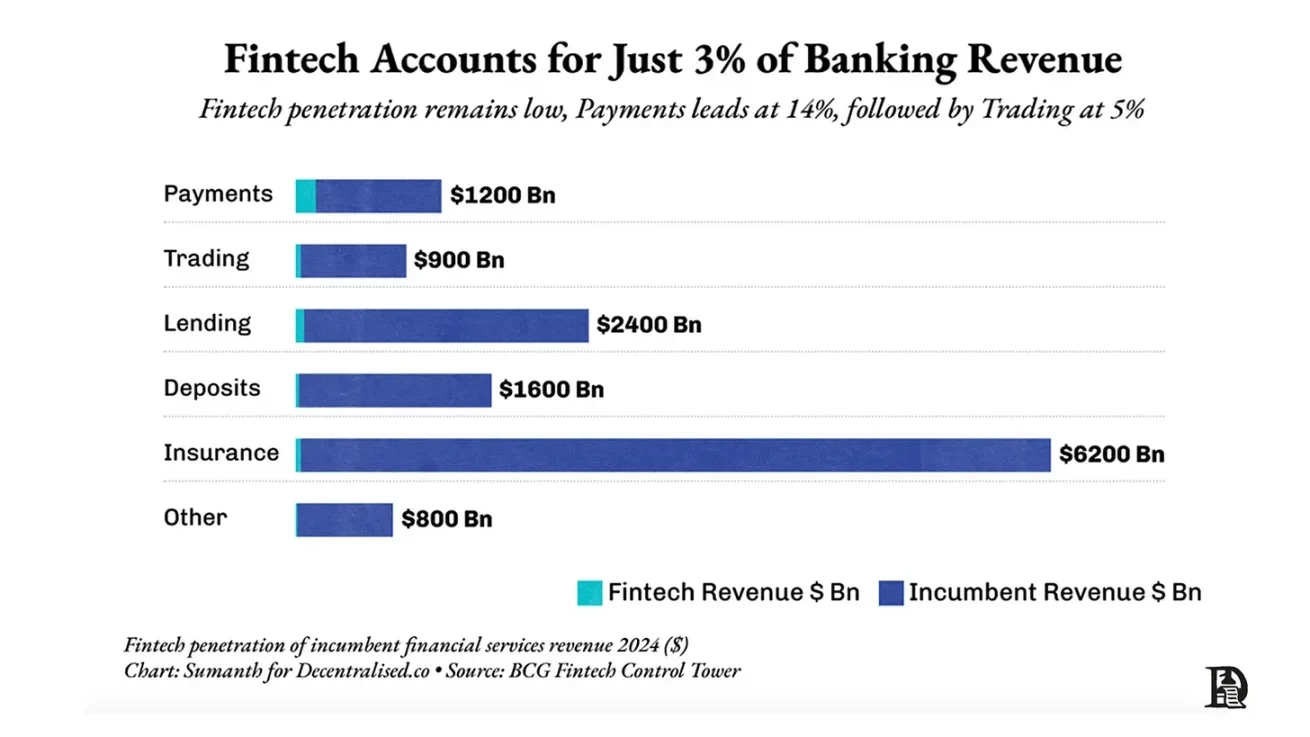
We tend to think so, which is partly why half of our portfolio is comprised of fintech startups.
Today’s article aims to demonstrate the unbundling of banks.
The new banks aren't housed in shiny offices downtown; they're in your social feeds, in your apps. Cryptocurrency has reached a stage of maturity where it's no longer relevant only for early adopters. It's begun flirting with the boundaries of fintech, allowing us to build things with a global total addressable market (TAM). What does this mean for investors, operators, and founders?
We try to find the answer in today's topic.
GENIUS Act in Mobility
Warren Buffett is known as the Oracle of Omaha for good reason; his portfolio performance is nothing short of miraculous. But behind this miraculous performance lies some often-overlooked financial engineering. Berkshire Hathaway possesses what could be considered permanent capital. In 1967, he acquired an insurance business with a stable supply of idle capital. In insurance parlance, he could tap into insurance float—the amount of premiums paid but not yet claimed—as an interest-free loan.
Contrast this with most fintech lending platforms. LendingClub is a startup focused on peer-to-peer lending. In this model, liquidity comes from other users on the platform. If I lend money to Saurabh and Sumanth on LendingClub, and they both don't repay, I might be less willing to lend to Siddharth on the same platform. This is because by then, my trust in the platform's ability to vet, verify, and bring in high-quality borrowers has eroded.
If you got into an accident every time you took an Uber, would you still use it?
Think of this, but for lending. LendingClub ultimately had to acquire Radius Bank for $185 million to gain a stable source of deposits to fund loan originations.
Similarly, SoFi spent nearly $1 billion over seven years to scale as a non-bank lender. Without a banking license, you're not allowed to take deposits and make them available to potential borrowers. Therefore, it had to fund its loans through partner banks, which eats up much of the interest earned. Think of it this way: I borrow money from Saurabh at 5% and lend it to Sumanth at 6%. This 1% margin is my profit on the loan. But if I had a stable source of deposits (like a bank), I could earn much more.
That's what SoFi ultimately did. In 2022, it acquired Sacramento-based Golden Pacific Bank for $22.3 million. The move was intended to secure a license allowing it to accept deposits. This change pushed its net interest margin to around 6%, well above the typical 3-4% for US banks.
Smaller bank wrappers couldn't generate profit margins large enough to operate. So what about giants like Google? Google launched Plex as a mechanism to embed a wallet directly into your Gmail app. It was built in partnership with a consortium of banks to handle deposits. The business involved Citigroup and Stanford Federal Credit Union, but it never launched. After two years of regulatory back and forth, Google canceled the project in 2021. In other words, you can have the largest inbox in the world, but it's hard to convince regulators why people should be allowed to move money where they send and receive emails. Such is life.
Venture capitalists understand this struggle. Since 2021, total funding flowing into fintech startups has halved. Historically, most of the moats for fintech startups have been regulatory. This is why banks capture the lion's share of the banking revenue pie. But when a bank misprices risk, it gambles with depositors' money, as we saw with Silicon Valley Bank.
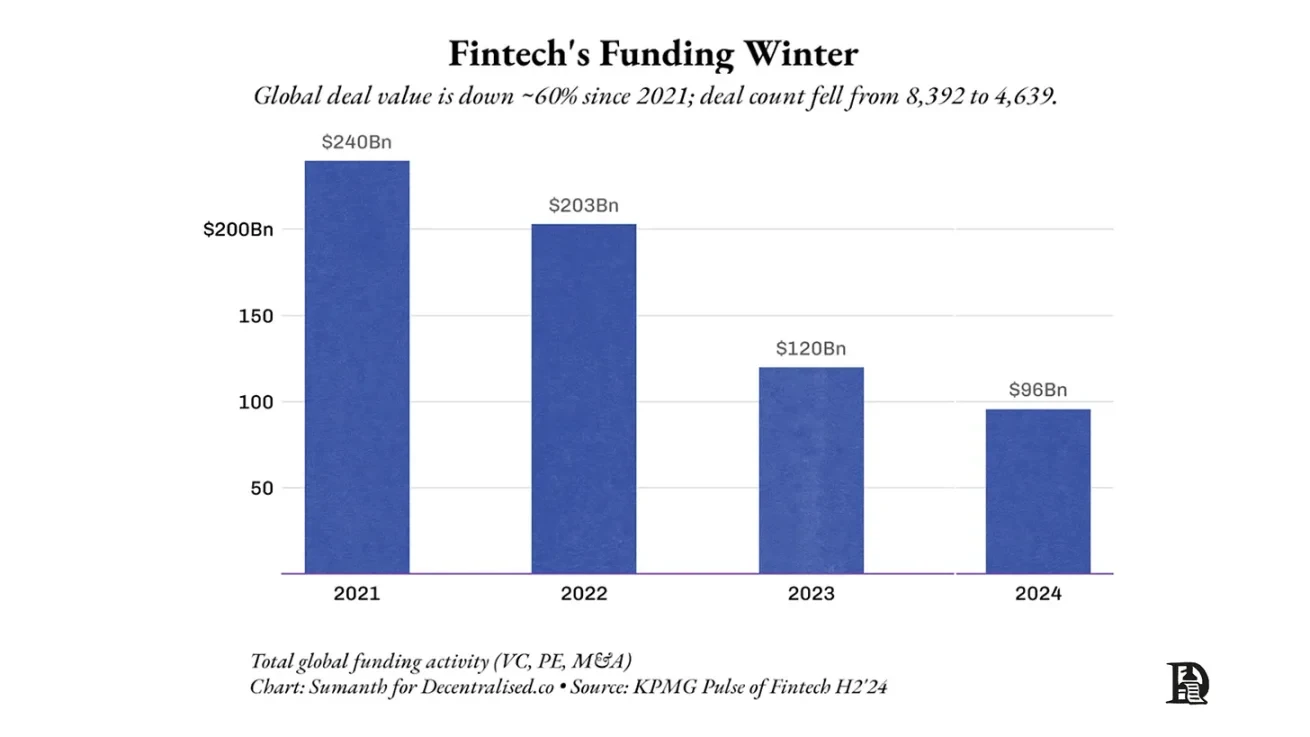
The GENIUS Act erodes this defensive moat. It allows non-bank institutions to hold user deposits in stablecoins, issue digital dollars, and settle payments 24/7. Lending and borrowing remain segregated, but custody, compliance, and liquidity are slowly transitioning to the realm of code. We may be entering a new era, where a new generation of Stripes will be built on these financial primitives.
But does this increase risk? Are we allowing startups to gamble with user deposits, or are we only allowing suits to do so? Not exactly. Digital dollars or stablecoins are generally much more transparent than their traditional counterparts. In the traditional world, risk assessment is a private matter. On-chain, it's publicly verifiable. We've already seen a version of this when ETF or DAT holdings can be verified on-chain—you can even verify how much Bitcoin countries like El Salvador or Bhutan hold.
The shift we will witness is that products may look like Web 2, but the assets are on Web 3 rails.
If blockchain rails enable faster money transfers, and digital primitives like stablecoins allow users to hold deposits by anyone under the right regulatory regime, then we will see the emergence of a new generation of banks with radically different unit economics.
But to understand this shift, it first helps to understand the components that make up a bank.
The building blocks of a bank
What exactly is a bank? At its core, it does four things:
First, it holds information about who owns how much assets, a database.
Second, it enables people to move money between each other through transfers and payments.
Third, it ensures compliance with users to ensure that the assets held by the bank are legal.
Fourth, it uses the information in its database to upsell loans, insurance, and trading products.
The way cryptocurrencies are cannibalizing these sectors is somewhat inverted. Stablecoins, for example, aren't full-fledged banks today, but they hold significant traction in terms of transaction volume. Visa and Mastercard have historically charged tolls on everyday transactions. Every swipe of a card eats into their moat, as merchants have no alternatives.
By 2011, US debit card fees averaged around 44 basis points, high enough for Congress to pass the Durbin Amendment, which slashed those rates in half. Europe lowered its caps in 2015 to 0.20% for debit cards and 0.30% for credit cards after Brussels determined the two giants were engaging in "coordination rather than competition." Yet uncapped US credit cards still charge 2.1%–2.4% today, only slightly lower than they were a decade ago.
Stablecoins have upended this economic model. On Solana or Base, a USDC transfer costs less than $0.20 in settlement fees, a flat fee regardless of the amount. Shopify merchants accepting USDC through self-hosted wallets can retain the 2% credit card network fee they once charged. Stripe has seen the signs. It now offers a 1.5% fee on USDC transactions, down from its 2.9% + $0.30 fee rate.
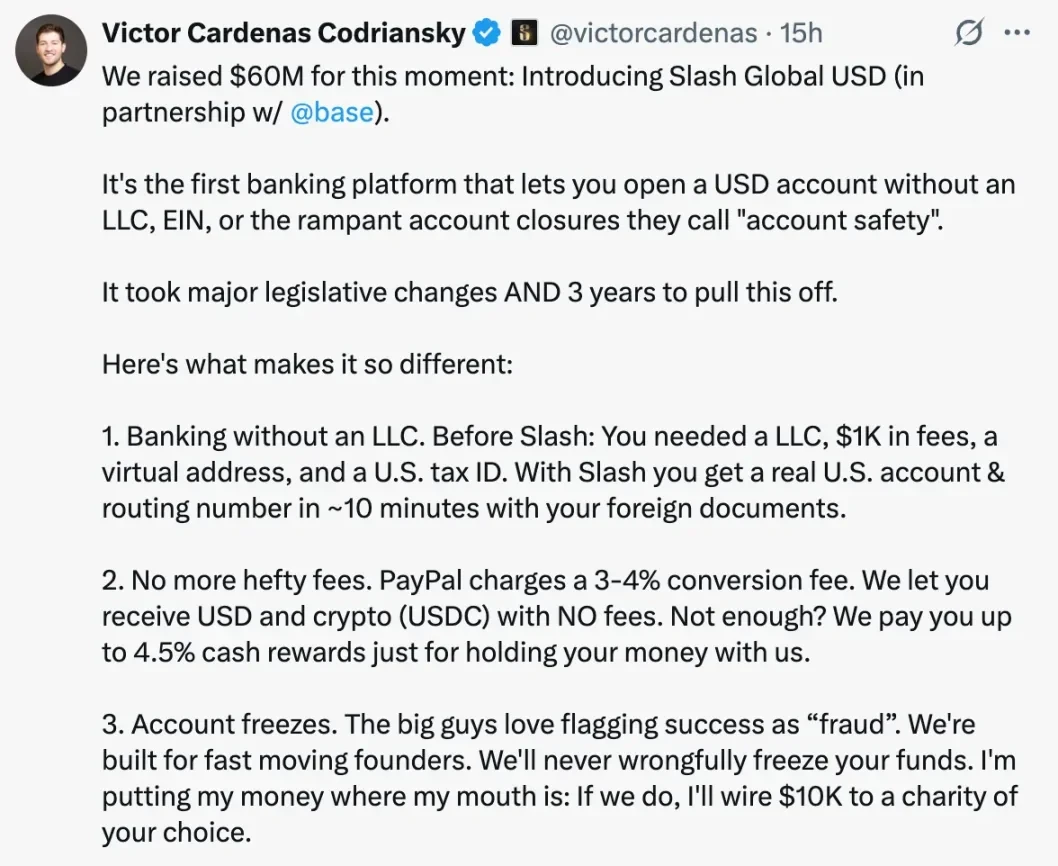
New way money flows in the United States
These rails invite new participants at a much lower cost. YC-backed Slash lets any exporter start accepting payments from US customers in five minutes, without a Delaware C-corporation, acquiring bank contracts, paperwork, or attorney fees—just a wallet. The message to traditional processors is straightforward: upgrade to stablecoins or lose card revenue.
For users, the economic rationale is simple.
Accepting stablecoins in emerging markets means eliminating the hassles and staggering fees associated with foreign exchange.
It is also the fastest way to send funds across borders, especially for merchants with downstream import payment needs.
You save the roughly 2% fees you'd pay Visa and Mastercard. There are off-ramping costs, but in most emerging markets, stablecoins trade at a premium to the dollar. USDT currently trades at 88.43 rupees in India, while Transferwise offers the dollar at 87.51 rupees.
The economic rationale for stablecoins' acceptance in emerging markets is straightforward. They're cheaper, faster, and more secure. In regions like Bolivia, where inflation is reaching 25%, stablecoins offer a viable alternative to government-issued currencies. Essentially, stablecoins have given the world a taste of what blockchains as financial rails could look like. A natural progression would be to explore what other financial primitives these rails could enable.
Merchants converting cash to stablecoins quickly discover that the problem isn’t receiving the funds, but operating their business on-chain. Funds still need to be stored in vaults, yesterday’s transactions must be reconciled, suppliers expect payments, payroll needs to be streamed, and auditors demand proof.
The bank packaged all of this stuff in its core banking system, a mainframe-era behemoth written in Cobol that maintained ledgers, enforced deadlines, and pushed batch files.
Core banking software (CBS) does two basic jobs:
- Maintain a tamper-proof ledger of truth: who owns what, mapping accounts to customers.
- Securely expose the ledger to the outside world: supporting payments, loans, cards, reporting, and risk management.
Banks outsource this work to CBS software providers. These providers are technology companies that specialize in software, while banks specialize in the financial aspects. This architecture has its roots in the computerization of the 1970s, when branches transitioned from paper ledgers to connected data centers and then ossified under a mountain of regulations.
The FFIEC, an organization that publishes operating procedures for all U.S. banks, spells out the rules core banking software should follow: locating primary and backup data centers in separate geographic regions, maintaining redundant telecommunications and power lines, maintaining continuous transaction logs, and continuously monitoring for any security incidents.
Replacing a core banking system is a highly complex undertaking, as data—every customer balance and transaction—is trapped in the vendor's database. Migration means weekend cutovers, running dual ledgers, fire drills with regulators, and the high probability of failure the next morning. This built-in stickiness turns core banking into a near-permanent lease. The top three vendors, Fidelity Information Services (FIS), Fiserv, and Jack Henry, all date back to the 1970s and still lock banks into contracts for approximately seventeen years. Together, they serve over 70% of banks and nearly half of credit unions.
Pricing is based on usage: A retail checking account costs between $3 and $8 per month, decreasing with volume but increasing with add-ons like mobile banking. Turn on fraud tools, FedNow payment rails, and analytics dashboards, and the fees climb even higher.
Fiserv alone is projected to generate $20 billion in revenue from banks in 2024, roughly 10 times the amount of Ethereum on-chain fees during the same period.
By putting the assets themselves on a public blockchain, the data layer is no longer proprietary. USDC balances, tokenized treasuries, and loan NFTs all sit on the same open ledger, readable by any system. If a consuming application decides its current "core layer" is too slow or too expensive, it doesn't need to migrate Byte's state; it simply points a new orchestration engine to the same wallet address and continues running.
That said, switching costs don't drop to zero; they simply mutate. Payroll providers, ERP systems, analytics dashboards, and audit pipelines all need to integrate with the new core. Switching vendors means rewiring these hooks, not unlike switching cloud providers. The core is more than just a ledger; it also runs business logic: mapping user accounts, deadlines, approval workflows, and exception handling. Even if the balance is portable, recoding this logic in the new tech stack still requires effort.
The difference is that these frictions are now software problems, not data hostage issues. There's still the glue work of coding workflows, but those are sprint-based issues, not multi-year hostage negotiations. Developers can even adopt a multi-core strategy, with one engine for retail wallets and another for treasury operations, since both point to the same authoritative blockchain state. If one provider experiences an issue, they can fail over by redeploying the container, rather than orchestrating a data migration.
The future of banking viewed through these lenses could look very different. These components exist in silos today, waiting for developers to package them together for retail users.
Fireblocks secures over $10 trillion in token flows for banks like BNY Mellon, and its policy engine can mint, route, stake, and reconcile stablecoins on over 80 chains.
Safe protects a roughly $100 billion Smart Account Treasury; its SDK provides simple onboarding, multi-signature strategies, gas abstraction, streaming payroll, and automatic rebalancing for any application.
Anchorage Digital, the first chartered crypto bank, leases a regulated balance sheet that understands Solidity. Franklin Templeton Fund Group minted its Benji Treasury Bond Fund directly into Anchorage custody, settling shares on T+0 instead of T+2.
Coinbase Cloud provides wallet issuance, MPC custody, and sanctions-checked transfers as a single API.
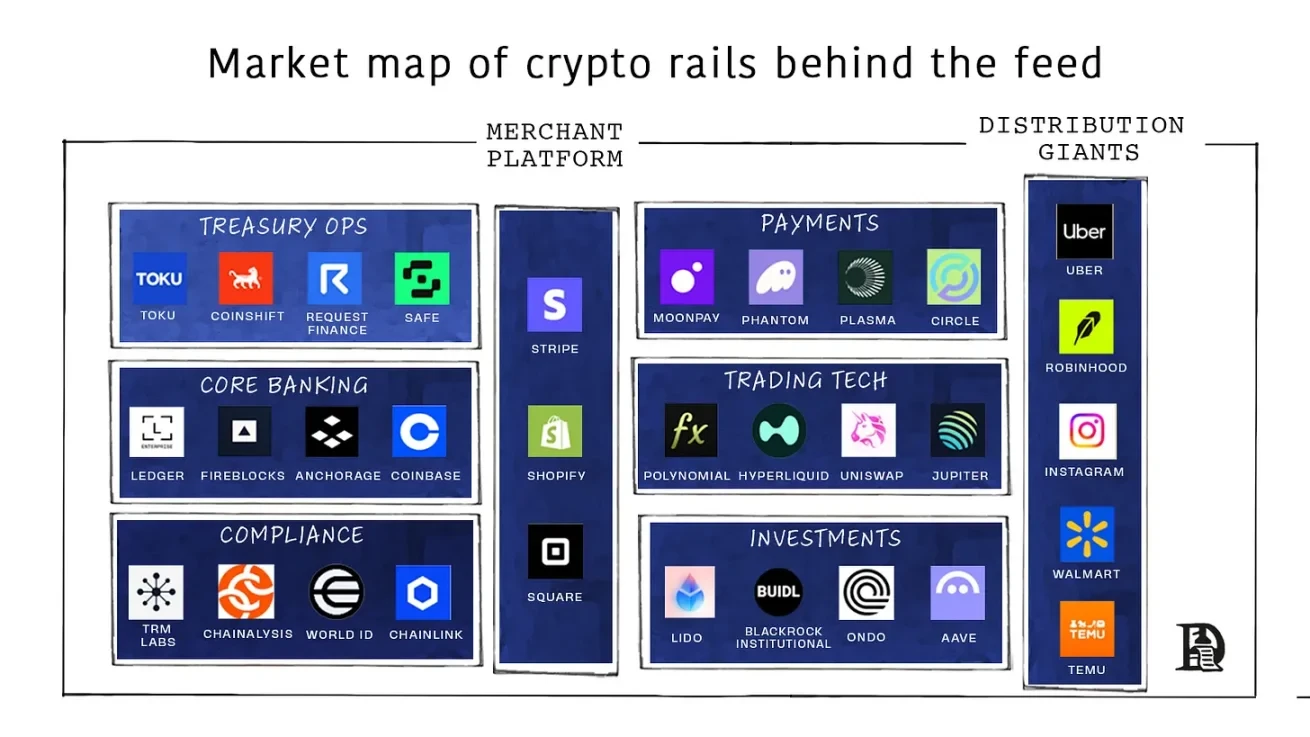
These players possess elements that traditional vendors lack: an understanding of on-chain assets, AML compliance built into the protocol, and event-driven APIs rather than batch files. Compare this to a market projected to grow from approximately $17 billion today to approximately $65 billion by 2032, and the equation is simple: the column that once belonged to Fidelity and its partners is now up for grabs, and companies that deliver products in Rust and Solidity rather than Cobol will grab it.
But before they are truly ready for retail, they need to battle the great evil that all financial products battle: compliance. What might compliance look like in an increasingly on-chain world?
Code is Compliance
Banks run four types of compliance: knowing your customer (KYC and due diligence), screening counterparties (sanctions and PEP checks), monitoring funds (transaction monitoring with alerts and investigations), and reporting to regulators (SARs/CTRs, audits). This is massive, expensive, and ongoing. Global spending exceeded $274 billion in 2023, and the burden increases almost every year.
The scale of the paperwork reveals patterns of risk. Last year, FinCEN tallied about 4.7 million suspicious activity reports and 20.5 million currency transaction reports, which are forms filed after the fact about risk. The work is batch-heavy: collecting PDFs and logs, compiling narratives, filing reports, and waiting.
For on-chain transactions, compliance stops being a collection of artifacts and starts operating like a live system. The FATF's "Travel Rule" requires originator/beneficiary information to accompany transfers; cryptocurrency providers must obtain, hold, and transmit this data (traditionally above the "occasional transaction" threshold of $1,000 USD/€1,000). The EU goes further, applying the rule to all cryptocurrency transactions. On-chain, this payload can be transmitted as an encrypted data block alongside the transfer, accessible to regulators but invisible to the public. Chainlink and TRM publish sanctions lists and fraud oracles; transfers query the lists during the transaction and revert if the address is flagged.
Privacy is also protected once zero-knowledge wallets like Polygon ID or World ID can carry a cryptographic badge proving, for example, “I am over 18 and not on any sanctions list.” Merchants get the green light, regulators get an auditable trail, and users never have to reveal their passport scans or street addresses.
Fast, liquid markets are useless if money is stuck in back-office paperwork. Vanta is an example of a regulatory technology (reg-tech) startup that has moved SOC 2 compliance from consultants and screenshots to APIs. Startups selling software to Fortune 500 companies need a SOC 2 certificate. This should demonstrate that you adhere to reasonable security practices and avoid storing customer data in unprotected, publicly accessible locations.
Startups often have to hire auditors, who hand over a giant spreadsheet requesting screenshots of everything from AWS setup to Jira tickets, disappear for six months, and then return with a signed, expiring PDF. Vanta simplifies this ordeal with a single API. Instead of hiring a consultant, you connect Vanta to AWS, GitHub, and your HR stack; it monitors the logs, automatically takes the same screenshots, and provides them to the auditor. This strategy has propelled Vanta to $200 million in annual recurring revenue (ARR) and a $4 billion valuation.

Linear's founder laments the state of compliance
Finance will follow the same trajectory: less binder management and more policy engines evaluating events in real time, leaving behind cryptographic receipts. Balances and flows are transparent, time-stamped, and cryptographically signed, making auditing a matter of observation.
Oracles like Chainlink act as messengers of truth between the off-chain rulebook and on-chain execution. Its Proof-of-Reserve data stream makes reserve adequacy transparent to the contract, allowing issuers and venues to connect circuit breakers that react automatically. The ledger is continuously monitored, eliminating the need to wait for annual audits.
Proofs of reserves gradually reach liquid collateral levels; if a stablecoin's collateralization ratio falls below 100%, the minting function automatically locks and notifies regulators.
There's still real work ahead. Authentication, cross-jurisdictional rules, edge case investigations, and machine-readable policies all need strengthening. The next few years will feel less like paperwork and more like API versioning: regulators publish machine-readable rules, oracle networks and compliance vendors provide reference adapters, and auditors move from sampling to oversight. As regulators understand what real-time auditing can achieve, they will work with vendors to implement a new class of tools.
A new era of trust
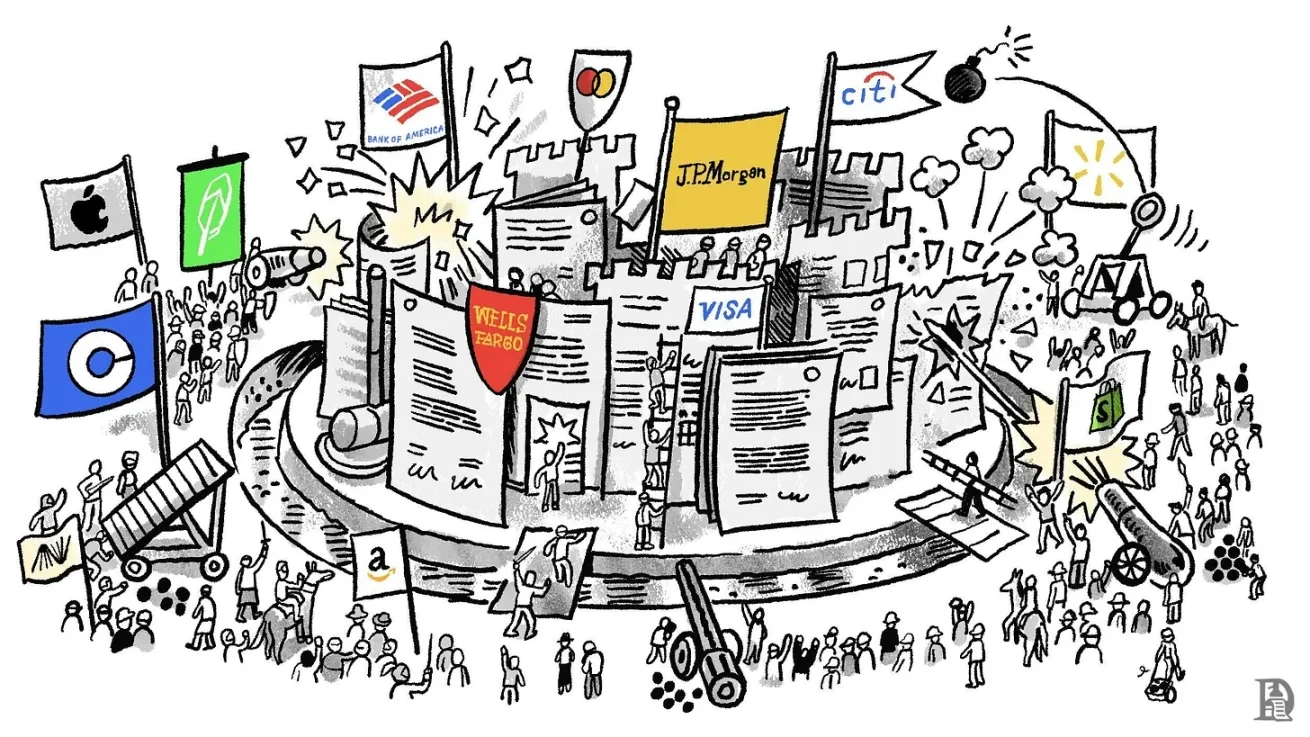
Everything is being bundled, then steadily unbundled. The story of humanity is one of continually trying to increase efficiency by integrating things together, only to realize decades later that they were better off remaining independent. The nature of legislation surrounding stablecoins and the current state of underlying networks (Arbitrum, Solana, Optimism) means we'll see repeated attempts to rebuild banks. Yesterday, Stripe announced its own attempt to launch an L1.
There are two forces working together in modern society.
- Costs have risen due to inflation.
- As our world becomes hyperconnected, meme desires rise.
In an era of increasing consumer spending and stagnant wages, more people are taking control of their finances. The GameStop surge, the rise of meme coins, and even the frenzy surrounding Labubu or the Stanley Cup are all manifestations of this shift. This means that applications with sufficient distribution capabilities and embedded trust will evolve into banks. What we will see is the expansion of Hyperliquid's builder-code system to the entire financial world. Whoever owns the distribution channels will ultimately become the bank.
If your most trusted influencer recommends a portfolio on Instagram, why would you trust JPMorgan? Why bother trading on Robinhood when you can trade directly on Twitter? What about me? Personally, my preferred mechanism for losing money would be to deposit it on Goodreads and buy rare books. My point is that with the introduction of the GENIUS Act, the legislation allowing products to hold user deposits has changed. In a world where the mobile components of a bank become API calls, more products will mimic banks.
Platforms that own the information flow will be the first to undergo this shift, and this isn't a completely new phenomenon. In their early days, social networks relied heavily on activity on e-commerce platforms for monetization, as that's where the money changed hands. A user seeing an ad on Facebook might purchase a product on Amazon, generating referral revenue for Facebook. In 2008, Amazon launched an app called Beacon that specifically monitors platform activity for wishlist creation. Throughout the history of the internet, there has been a graceful waltz between attention and commerce. Embedding banking infrastructure within platforms is another mechanism for getting closer to where the money resides.
Won't established players jump on the bandwagon of providing access to digital assets? Existing fintechs won't sit idly by, right? FIS is in talks with nearly every bank and knows what's happening. Ben Thompson's point in his recent article is simple and brutal: when a paradigm flips, yesterday's winners are at a disadvantage because they want to keep doing what they did when they won. They optimize for the old game, defend the old KPIs, and make the right decisions for the wrong world. This is the winner's curse, and it applies equally to blockchain-based money.
When everything is a bank, nothing is a bank. If users don't trust a single platform to hold the majority of their wealth, there will be a fragmentation in where funds are stored. This is already happening for crypto-native users who store the majority of their wealth in exchanges rather than banks. This means the unit economics of bank revenue generation will shift. Smaller applications may not need as much revenue as large banks to operate, as the majority of their operations can occur without human involvement. But this means the slow demise of traditional banking as we know it.
Perhaps, like life, technology is nothing more than a continuum of creation and destruction, of binding and unbinding.



